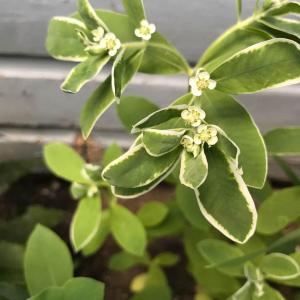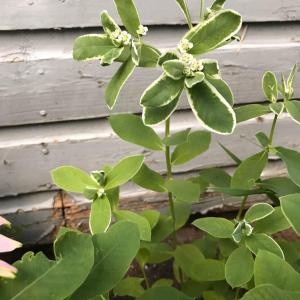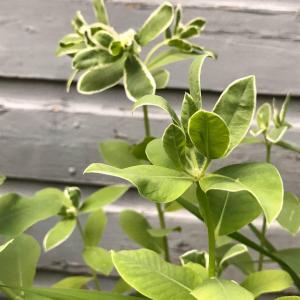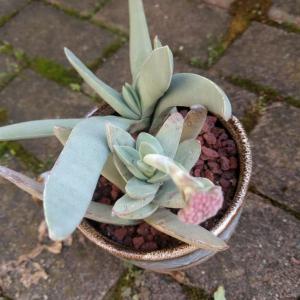Judikay
2017年07月19日

New flower I received at a plant exchange this June. There was no tag on it when I got home; it must've gotten lost on the way, it was chaos at that exchange. My first one ;))
Interesting plant: I received it in several stems so I planted it en mass figuring I'll know what to do when it grows up. It's now about 18" tall, & the top leaves near the flowers just turned variegated. It's not fragrant, the flowers are white & tiny.
Anyone have any idea what it is?




Interesting plant: I received it in several stems so I planted it en mass figuring I'll know what to do when it grows up. It's now about 18" tall, & the top leaves near the flowers just turned variegated. It's not fragrant, the flowers are white & tiny.
Anyone have any idea what it is?




0
0
文章
Dummer. ゛☀
2017年07月19日

Family - Orchidaceae
Stems - Plant is without a stem until flowering. Flowering stem thin, glabrous, to 40cm tall but typically shorter, erect, herbaceous, simple, from a tuberous root. Root pubescent, typically single but often with the previous season's root persisting.

Leaves - Basal rosette, few, ovate, to +3cm long, +1.5cm wide. Absent at flowering time (anthesis).
Plant rarely with small cauline leaves (bracts).
Inflorescence - Single spike to 9cm long, with some 25 flowers in a single spiral, flowers appearing secund on the axis.

Flowers - Corolla white, glabrous, small, 2.5-4mm long, lip erose to undulate or crisped (curled).

Flowering - August - October.
Habitat - Acid soils of upland pine, oak, or hickory forest (associated with granite, chert or sandstone substrata). Also in dry upland prairies and meadows.
Origin - Native to U.S.
Other info. - This is a fairly common species in Missouri. The plant can be identified by its tiny white flowers which are in a single spiral around the axis of the inflorescence. Each plant typically has one tuberous root but some plants have the tuberous root persisting from the previous season and thus have two roots.
Stems - Plant is without a stem until flowering. Flowering stem thin, glabrous, to 40cm tall but typically shorter, erect, herbaceous, simple, from a tuberous root. Root pubescent, typically single but often with the previous season's root persisting.

Leaves - Basal rosette, few, ovate, to +3cm long, +1.5cm wide. Absent at flowering time (anthesis).
Plant rarely with small cauline leaves (bracts).
Inflorescence - Single spike to 9cm long, with some 25 flowers in a single spiral, flowers appearing secund on the axis.

Flowers - Corolla white, glabrous, small, 2.5-4mm long, lip erose to undulate or crisped (curled).

Flowering - August - October.
Habitat - Acid soils of upland pine, oak, or hickory forest (associated with granite, chert or sandstone substrata). Also in dry upland prairies and meadows.
Origin - Native to U.S.
Other info. - This is a fairly common species in Missouri. The plant can be identified by its tiny white flowers which are in a single spiral around the axis of the inflorescence. Each plant typically has one tuberous root but some plants have the tuberous root persisting from the previous season and thus have two roots.
0
1
文章
Dummer. ゛☀
2017年07月18日

Family - Apiaceae
Stems - Stout, glabrous (entire plant), herbaceous, hollow, ribbed and angled, to 2m tall, slightly zig-zag in form, erect but reclining with age, branching, from thickened roots, rooting at lower nodes, with a sweet fennel fragrance.

Leaves - Alternate, odd-pinnate, petiolate to sessile. Lowest leaves to +50cm long, reduced above. Petiole to +7cm long, sheathing, ribbed or angled, with an adaxial groove. Lateral leaflets sessile, opposite, linear to lanceolate or lance-ovate, to +/-15cm long, 6cm broad, serrulate to serrate, deep green adaxially, lighter shiny-green abaxially, glabrous, acute to acuminate at apex, larger leaflets typically rounded and oblique at the base. Terminal leaflet with a petiolule to +3cm long.

Inflorescence - Terminal and axillary compound umbels. Peduncles to +6cm long, ribbed and angled. Primary rays to 3.5 cm long, subtended by recurved bracts, glabrous. Bracts to -2cm long, 2-3mm broad, linear-lanceolate to lance-attenuate, with scarious margins, +/-12. Umbellets with raylets to 8mm long, subtended by similar but smaller bracts than main rays. Raylets to 8mm long, glabrous. Umbellets with 25-35 flowers.
Flowers - Petals 5, white, spreading, glabrous, obovate, with an inflexed apiculate apex, to 1.5mm long, 1.3mm broad. Stamens 5, alternating with petals, spreading. Filaments white, to 2mm long. Anthers whitish-pink to pink or yellow, .2mm broad. Styles 2, distinct, very short, -.2mm long, with greenish-white stylopodium. Stylopodium to 1.1mm broad. Ovary inferior, ribbed, -1mm long in flower, 1.1mm broad, compressed slightly. Fruit oval to orbicular, to 3mm long.
Flowering - July - September.

Habitat - Wet areas.
Origin - Native to U.S.
Other info. - This highly variable species can be found throughout Missouri in wet habitats. As seen in the pictures above, the plant is very variable and can be hard to ID in the field. The characteristics to look for are the bracts and bracteoles subtending the rays and raylets of the inflorescence and the serrulate to serrate margins of the leaflets.
Stems - Stout, glabrous (entire plant), herbaceous, hollow, ribbed and angled, to 2m tall, slightly zig-zag in form, erect but reclining with age, branching, from thickened roots, rooting at lower nodes, with a sweet fennel fragrance.

Leaves - Alternate, odd-pinnate, petiolate to sessile. Lowest leaves to +50cm long, reduced above. Petiole to +7cm long, sheathing, ribbed or angled, with an adaxial groove. Lateral leaflets sessile, opposite, linear to lanceolate or lance-ovate, to +/-15cm long, 6cm broad, serrulate to serrate, deep green adaxially, lighter shiny-green abaxially, glabrous, acute to acuminate at apex, larger leaflets typically rounded and oblique at the base. Terminal leaflet with a petiolule to +3cm long.

Inflorescence - Terminal and axillary compound umbels. Peduncles to +6cm long, ribbed and angled. Primary rays to 3.5 cm long, subtended by recurved bracts, glabrous. Bracts to -2cm long, 2-3mm broad, linear-lanceolate to lance-attenuate, with scarious margins, +/-12. Umbellets with raylets to 8mm long, subtended by similar but smaller bracts than main rays. Raylets to 8mm long, glabrous. Umbellets with 25-35 flowers.
Flowers - Petals 5, white, spreading, glabrous, obovate, with an inflexed apiculate apex, to 1.5mm long, 1.3mm broad. Stamens 5, alternating with petals, spreading. Filaments white, to 2mm long. Anthers whitish-pink to pink or yellow, .2mm broad. Styles 2, distinct, very short, -.2mm long, with greenish-white stylopodium. Stylopodium to 1.1mm broad. Ovary inferior, ribbed, -1mm long in flower, 1.1mm broad, compressed slightly. Fruit oval to orbicular, to 3mm long.
Flowering - July - September.

Habitat - Wet areas.
Origin - Native to U.S.
Other info. - This highly variable species can be found throughout Missouri in wet habitats. As seen in the pictures above, the plant is very variable and can be hard to ID in the field. The characteristics to look for are the bracts and bracteoles subtending the rays and raylets of the inflorescence and the serrulate to serrate margins of the leaflets.
0
0
文章
Dummer. ゛☀
2017年07月17日

Family - Rosaceae.
Flowering - April - June.
Habitat - Open woods, bluffs, thickets.
Origin - Native to U.S.
Other info. - This attractive and tasty species can be found throughout Missouri. The plant is commonly cultivated and many horticultural varieties exist. It is commonly called Black Raspberry.
R. occidentalis is easy to identify becasue of its very glaucous stems and typically 5-parted leaves. The fruits ripen at different rates and make attractive infructescences. The abaxial surface of the leaves are very whitish.

Flowering - April - June.
Habitat - Open woods, bluffs, thickets.

Origin - Native to U.S.
Other info. - This attractive and tasty species can be found throughout Missouri. The plant is commonly cultivated and many horticultural varieties exist. It is commonly called Black Raspberry.

R. occidentalis is easy to identify becasue of its very glaucous stems and typically 5-parted leaves. The fruits ripen at different rates and make attractive infructescences. The abaxial surface of the leaves are very whitish.
0
0
文章
Dummer. ゛☀
2017年07月17日

Family - Apiaceae.
Flowering - June - August.
Habitat - Moist to wet open ground.
Origin - Native to U.S.
Other info. - This little species can be found in only a handful of southeastern Missouri counties. The plant is very infrequent in the state and appears to reach the northwest corner of its range here.

This species can be distinguished from the two other species of Ptilimnium in the state by its very short styles and divided bracts, which subtend the primary rays of the inflorescence.

Flowering - June - August.
Habitat - Moist to wet open ground.
Origin - Native to U.S.
Other info. - This little species can be found in only a handful of southeastern Missouri counties. The plant is very infrequent in the state and appears to reach the northwest corner of its range here.


This species can be distinguished from the two other species of Ptilimnium in the state by its very short styles and divided bracts, which subtend the primary rays of the inflorescence.
0
0
文章
Dummer. ゛☀
2017年07月16日

Family - Liliaceae
Stems - From bulbs. Aerial stems to +40cm long (tall), erect, herbaceous, terete, green, glabrous, simple, single from the base.

Leaves - Mostly near the base of the plant and in a rosette, glabrous, flat but typically somewhat folded, green, to +45cm long, +1cm broad, linear and grass-like, succulent, with parallel veins.
Inflorescence - Terminal raceme. Pedicels to +1cm long in flower, glabrous, ascending in bud, nodding in flower. Each pedicel subtended by a scarious attenuate bract. Bracts brownish, glabrous, to -4cm long, 1cm broad at the base.
Flowers - Tepals 6, spreading. glabrous, +/-3cm long, +/-8mm broad, white with a green midstripe, acute, oblong-lanceolate, distinct. Stamens 6, erect, connivent around the style. Filaments compressed, white, to 1.5cm long, 3-4mm long. Some (3) of the filaments expanded beyond the anthers with two erect appendages. Anthers pale yellow to white, to +5mm long, 2mm broad. Ovary dark green, glabrous, ovoid, 3-ribbed, 5mm long in flower, 3mm in diameter, 3-locular, placentation axile, ovules many. Style white, 7-8mm long, glabrous, with 2 vertical grooves.
Flowering - April - May.
Habitat - Cultivated and rarely escaped. Persistent around old homesites.
Origin - Native to Asia.
Other info. - This attractive species is commonly cultivated throughout Missouri and is rarely escaped. It is not nearly as common as the closely related O. umbellatum L. which is escaped nearly throughout the state.
The genus Ornithogalum is toxic and contains many alkaloids.
Stems - From bulbs. Aerial stems to +40cm long (tall), erect, herbaceous, terete, green, glabrous, simple, single from the base.

Leaves - Mostly near the base of the plant and in a rosette, glabrous, flat but typically somewhat folded, green, to +45cm long, +1cm broad, linear and grass-like, succulent, with parallel veins.
Inflorescence - Terminal raceme. Pedicels to +1cm long in flower, glabrous, ascending in bud, nodding in flower. Each pedicel subtended by a scarious attenuate bract. Bracts brownish, glabrous, to -4cm long, 1cm broad at the base.

Flowers - Tepals 6, spreading. glabrous, +/-3cm long, +/-8mm broad, white with a green midstripe, acute, oblong-lanceolate, distinct. Stamens 6, erect, connivent around the style. Filaments compressed, white, to 1.5cm long, 3-4mm long. Some (3) of the filaments expanded beyond the anthers with two erect appendages. Anthers pale yellow to white, to +5mm long, 2mm broad. Ovary dark green, glabrous, ovoid, 3-ribbed, 5mm long in flower, 3mm in diameter, 3-locular, placentation axile, ovules many. Style white, 7-8mm long, glabrous, with 2 vertical grooves.
Flowering - April - May.

Habitat - Cultivated and rarely escaped. Persistent around old homesites.
Origin - Native to Asia.
Other info. - This attractive species is commonly cultivated throughout Missouri and is rarely escaped. It is not nearly as common as the closely related O. umbellatum L. which is escaped nearly throughout the state.
The genus Ornithogalum is toxic and contains many alkaloids.
0
0
文章
Dummer. ゛☀
2017年07月16日

Family - Nymphaeaceae
Flowering - May - September.
Habitat - Ponds and sloughs.

Origin - Native to U.S.
Other info. - This striking species can be found scattered throughout Missouri. The plant is common in many ponds and lakes throughout the eastern and central U.S.
N. odorata has pleasantly fragrant flowers and makes a great plant in home fish ponds. The plant is widely cultivated and many flower colors exist. White is the typical flower color.
Traditionally the plant was used by natives to treat a variety of ailments. A tea made from the roots was used for coughs, mouth sores, and for tuberculosis.
The starchy roots are eaten by wildlife.
Flowering - May - September.
Habitat - Ponds and sloughs.


Origin - Native to U.S.
Other info. - This striking species can be found scattered throughout Missouri. The plant is common in many ponds and lakes throughout the eastern and central U.S.
N. odorata has pleasantly fragrant flowers and makes a great plant in home fish ponds. The plant is widely cultivated and many flower colors exist. White is the typical flower color.

Traditionally the plant was used by natives to treat a variety of ailments. A tea made from the roots was used for coughs, mouth sores, and for tuberculosis.
The starchy roots are eaten by wildlife.
0
0
文章
Dummer. ゛☀
2017年07月16日

Family - Monotropaceae, (Ericaceae) (Pyrolaceae)
Flowering - August - October.
Habitat - Dry upland woods, ravines, thickets, slopes, ridges.


Origin - Native to U.S.
Other info. - This unique plant can be found throughout much of Missouri but is apparently absent from the west-central portion of the state. The plant grows in thick leaf litter (mulch) and is saprophytic. This is probably the easiest plant in Missouri to identify as nothing else resembles it. Another species, M. hypopithys L., has the same growth pattern but is a yellow to gold plant which turns red when fruiting. This latter species is less common in Missouri.
M. uniflora is pure white when fresh and begins to turn black upon drying. The fruits of the plant become completely erect as opposed to the flowers which nod.
Traditionally the plant was used to treat warts, inflammation, and general pains. A root tea was used to treat convulsions and epilepsy. The plant contains glycosides and is probably toxic.
Three families are listed above because the taxonomy of this group seems to change daily.
Flowering - August - October.

Habitat - Dry upland woods, ravines, thickets, slopes, ridges.


Origin - Native to U.S.
Other info. - This unique plant can be found throughout much of Missouri but is apparently absent from the west-central portion of the state. The plant grows in thick leaf litter (mulch) and is saprophytic. This is probably the easiest plant in Missouri to identify as nothing else resembles it. Another species, M. hypopithys L., has the same growth pattern but is a yellow to gold plant which turns red when fruiting. This latter species is less common in Missouri.
M. uniflora is pure white when fresh and begins to turn black upon drying. The fruits of the plant become completely erect as opposed to the flowers which nod.
Traditionally the plant was used to treat warts, inflammation, and general pains. A root tea was used to treat convulsions and epilepsy. The plant contains glycosides and is probably toxic.
Three families are listed above because the taxonomy of this group seems to change daily.
0
0
文章
Dummer. ゛☀
2017年07月16日

Family - Magnoliaceae
Flowering - March - April.
Habitat - Cultivated.
Origin - Native to Japan.


Other info. - This striking cultivated plant from Japan was first brought to the U.S. around 1860. Since that time at least 8 cultivars have been produced. The plant is commonly cultivated throughout Missouri in lawns and business landscapes. This species can grow to about 6m tall and can be trained as a tree or a shrub. The big white flowers appear before the leaves and last for about a week or two.
The Japanese word for the plant is Side_kobusi.
Flowering - March - April.

Habitat - Cultivated.
Origin - Native to Japan.


Other info. - This striking cultivated plant from Japan was first brought to the U.S. around 1860. Since that time at least 8 cultivars have been produced. The plant is commonly cultivated throughout Missouri in lawns and business landscapes. This species can grow to about 6m tall and can be trained as a tree or a shrub. The big white flowers appear before the leaves and last for about a week or two.
The Japanese word for the plant is Side_kobusi.
0
0
文章
Dummer. ゛☀
2017年07月16日

Family - Ericaceae
Flowering - May - June.
Habitat - Sandy pine-oak woods.
Origin - Native to U.S.
Other info. - This attractive, shrubby species is very rare in Missouri and can only be found in one Ozark county. The plant reaches the westernmost portion of its range in Missouri, Texas, Oklahoma, and Arkansas. It is much more common in the eastern U.S.
L. mariana is easy to identify in flower because of its large, tubular, white flowers which hang in groups. The leaves of the plant have been reported as being toxic.
Flowering - May - June.

Habitat - Sandy pine-oak woods.

Origin - Native to U.S.
Other info. - This attractive, shrubby species is very rare in Missouri and can only be found in one Ozark county. The plant reaches the westernmost portion of its range in Missouri, Texas, Oklahoma, and Arkansas. It is much more common in the eastern U.S.
L. mariana is easy to identify in flower because of its large, tubular, white flowers which hang in groups. The leaves of the plant have been reported as being toxic.

0
0
文章
Dummer. ゛☀
2017年07月16日

Family - Fabaceae
Flowering - July - October.

Habitat - Acid soils of open woods, glades, and dry open ground.

Origin - Native to U.S.
Other info. - This species can be found in the southern half of Missouri. The plant is easy to identify becasue of its tall, erect, hirsute stems, its white flowers, and its rounded leaves. This is a common bean species of the dry, cherty slopes of the Ozarks.
Flowering - July - October.

Habitat - Acid soils of open woods, glades, and dry open ground.

Origin - Native to U.S.
Other info. - This species can be found in the southern half of Missouri. The plant is easy to identify becasue of its tall, erect, hirsute stems, its white flowers, and its rounded leaves. This is a common bean species of the dry, cherty slopes of the Ozarks.

0
0
文章
Dummer. ゛☀
2017年07月16日

Family - Urticaceae
Flowering - May - September.
Habitat - Bottomland forests, wet woods, floodplain forests.
Origin - Native to U.S.
Other info. - This species can be found throughout Missouri. The plant can be found in large quantities in bottomland forests and river floodplain forests. In Missouri, the plant is nearly always associated with other floodplain species like Elymus virginicus and Viola striata.
L. canadensis can be identified by its alternate, long-petiolate leaves, and painful stinging hairs. All parts of the plant contain the stinging hairs. The itching pain from the hairs lasts only a few minutes.
Flowering - May - September.

Habitat - Bottomland forests, wet woods, floodplain forests.

Origin - Native to U.S.
Other info. - This species can be found throughout Missouri. The plant can be found in large quantities in bottomland forests and river floodplain forests. In Missouri, the plant is nearly always associated with other floodplain species like Elymus virginicus and Viola striata.

L. canadensis can be identified by its alternate, long-petiolate leaves, and painful stinging hairs. All parts of the plant contain the stinging hairs. The itching pain from the hairs lasts only a few minutes.
0
0









